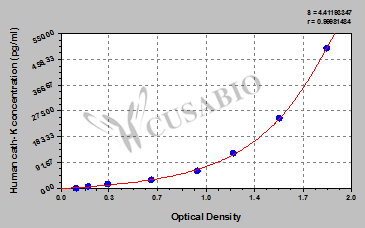This human CTSK ELISA kit employs the quantitative sandwich enzyme immunoassay technique to measure the levels of human CTSK in multiple samples, including serum, plasma, or tissue homogenates. The enzyme-substrate chromogenic reaction is also used to amplify the signal and quantify the levels of the analyte through the intensity of the colored product. The color intensity positively correlates with the amount of CTSK bound in the initial step.
CTSK is a cysteine proteinase that is primarily expressed in osteoclasts and mainly functions to mediate bone resorption. CTSK cleaves key bone matrix proteins like type I collagen and plays an important role in degrading the organic phase of bone during bone resorption. Mutations in the CTSK gene lead to an autosomal recessive osteosclerotic skeletal disorder-pycnodysostosis. CTSK is involved in cartilage matrix degradation and osteoarthritis (OA) because it also degrades type II collagen, the predominant matrix protein of cartilage.




